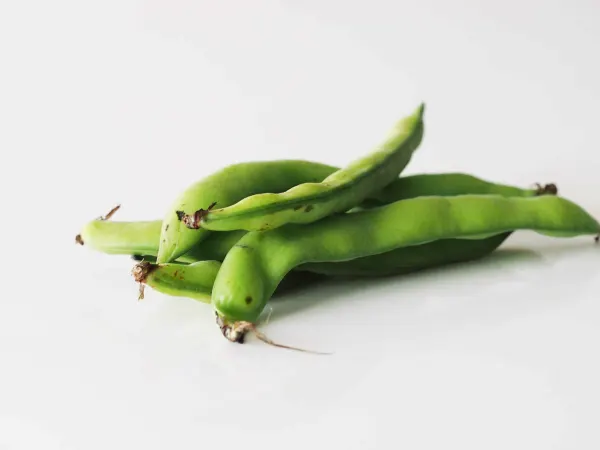Fava Bean (Broad Bean)
Legume
Age Suggestion
6 months
Iron-Rich
Yes
Common Allergen
No

Warning
If baby has a family history of G6PD deficiency (also known as favism), or is of African, Mediterranean, South Asian, or Southwest Asian descent, talk to the child’s medical provider before introducing fava bean. The legume is the main food trigger for individuals with G6PD deficiency, and when fava bean is consumed, these individuals can experience hemolytic anemia, which can lead to critical illness. Breastfeeding moms of similar backgrounds or with babies with G6PD should take care, as compounds from fava bean can be transferred into breast milk and cause reactions.
When can babies eat fava beans?
Fava bean (broad bean) may be introduced as soon as a baby is ready to start solids, which is generally around 6 months of age. Note: If a baby has a family history of G6PD deficiency (also known as favism), or is of African, Mediterranean, South Asian, or Southwest Asian (Middle Eastern) descent, talk to the child’s medical provider before introducing fava bean. The legume is the main food trigger for individuals with G6PD deficiency, and when fava bean is consumed, these individuals can experience hemolytic anemia, which can lead to critical illness.
This bean goes by many names: fava and haba in the Americas; cándòu and đậu rộng in Asia; and bagilla, bakla, and fūl in the Mediterranean region to name a few. Its name in English (broad bean) alludes to its shape as the plant matures and its seeds (or beans) swell and widen. The legume’s many names hints at its widespread use in kitchens across the globe.
Are fava beans healthy for babies?
Yes. Fava beans have got it all: plant-based protein, healthy fats, fiber, and energy from complex carbohydrates. They also contain lots of folate for brain and nervous system development, omega 3 fatty acids for healthy blood, and zinc for a robust immune system.
Are fava beans a common allergen?
No. Allergies to fava bean are rare, but possible. What is more common is “favism”, also called G6PD deficiency. For affected individuals, consuming fava beans can lead to serious health conditions, such as hemolytic anemia, jaundice, and brain damage. Symptoms of favism can include pale skin, jaundice, dark urine, fever, weakness, dizziness, confusion, and an increased heart rate. Although favism can occur at any age, it is more common and can be more severe in children (especially in boys).
If a baby has a family history of G6PD deficiency, or is of African, Mediterranean, South Asian, or Southwest Asian descent, talk to the child’s medical provider before introducing fava bean. Prevalence of the condition ranges widely between 5-30% in these regions, and G6PD deficiency may affect 10% of African American males in the United States. Breastfeeding moms of similar backgrounds and/or with babies with G6PD should also take this added precaution, as compounds from fava beans can be transferred into breast milk and cause reactions.
When introducing fava beans, start by offering a small quantity during the first serving, and watch for symptoms of hemolytic anemia over the next 24 hours. These can include irritability, lethargy, dark urine, pale appearance, a sudden increase in body temperature, shortness of breath, rapid heartbeat, abdominal or lower back discomfort, or yellowing of the whites of the eyes, mucus membranes, or skin. If there is no adverse reaction within 24 hours of the first serving, you can gradually increase the amount over future meals.
Are fava beans a choking hazard for babies?
Yes. Fava beans are small, rounded, and can be firm, especially when raw or undercooked, qualities that can increase the risk of choking. To reduce the risk, prepare and serve fava beans in an age-appropriate way. As always, make sure you create a safe eating environment and stay within an arm’s reach of baby during meals. For more information on choking, visit our sections on gagging and choking and familiarize yourself with the list of common choking hazards.
Videos
Do I need to start solids with purees?
You can if you’d like, but there's no developmental need to start with textureless food. Babies can be served modified versions of what you eat. Use our free First Foods Database to find how to safely serve any food.
What are some great first foods for babies?
There are many wonderful options. Look for foods that are easy for baby to feed to themselves, that are low in choking risk, and that offer nutrients babies need, such as iron. Some of our favorite first foods include steamed broccoli, oatmeal, and mango pits. See more ideas in our guide, 50 Fantastic First Foods.
How do you serve fava beans to babies?
Every baby develops on their own timeline, and the suggestions on how to cut or prepare particular foods are generalizations for a broad audience.
6 months old +:
Mash cooked fava beans and let baby scoop with their hands or eat from a pre-loaded spoon. You can also split or flatten cooked fava beans to serve as finger food. Serving flattened beans in a bowl or plate that suctions to the table can help babies scoop, but they may be more successful picking them up when they get a bit older and have a more precise pincer grasp. Note: Fava beans are a trigger for individuals with G6PD deficiency. If baby has a family history of G6PD deficiency, do not introduce fava beans without first talking with your health care provider.
9 months old +:
At this time babies develop a pincer grasp, enabling them to pick up smaller pieces of food. Continue to flatten each bean to reduce the risk of choking, and when a baby develops the pincer grasp, offer the beans directly on the tray or table to strengthen dexterity. Note: Fava beans are a trigger for individuals with G6PD deficiency. If baby has a family history of G6PD deficiency, do not introduce fava beans without first talking with your health care provider.
12 months old +:
At this age, if the toddler is chewing well and not overstuffing food in the mouth, offer whole cooked fava beans without flattening them. Watch the child carefully and coach them by dramatically modeling how to chew. This stage may also be a great time to introduce a fork. Show how it is used by pre-loading the fork or try spearing the beans while making a sound (boink!) in front of the child. If the child is not interested in using a utensil, don’t stress. Using utensils can be exhausting for new eaters, and many children toggle back and forth between feeding themselves with their fingers and utensils. Try not to apply too much pressure—consistent and accurate utensil use will come in due time—typically after the second birthday.
How often should you offer solids? See our sample feeding schedules for babies of every age.
Our Team
Written by
Expert Tips Delivered to Your Inbox
Sign up for weekly tips, recipes and more!
Copyright © 2024 • Solid Starts Inc





